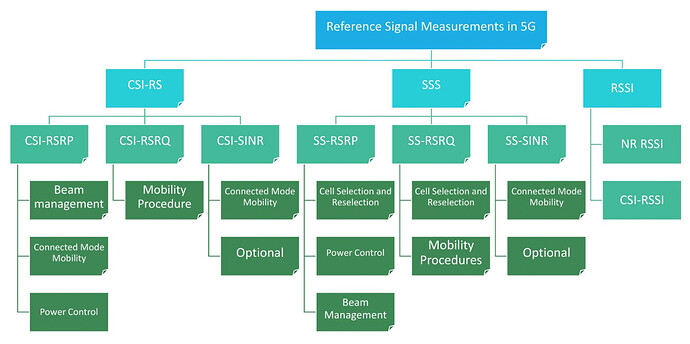In 5G, downlink reference signal measurements are done for SSS (Secondary Synchronization Signal) and CSI-RS (Channel State Information Reference Signal) instead of CRS (Cell Specific Reference Signal) used in LTE.
The following are the different types of UE measurements in 5G:
-
SS-RSRP: Synchronization Signal Reference Signal Received Power. It is defined as the linear average over the power contributions in the resource elements that carry SSS.
-
SS-RSRQ: Synchronization Signal Reference Signal Received Quality. It is defined as the ratio of N x SS-RSRP to NR-RSSI, where N is the number of resource blocks in the RSSI measurement bandwidth.
-
SS-SINR: Synchronization Signal Signal-to-Noise and Interference ratio. It is defined as the ratio of the SS-RSRP to the noise and interference power.
-
CSI-RSRP: Channel State Information reference signal received power. It is defined as the linear average over the power contributions in the resource elements that carry CSI-RS.
-
CSI-RSRQ: Channel State Information reference signal received quality. It is defined as the ratio of N x CSI-RSRP to CSI-RSSI, where N is the number of resource blocks in the RSSI measurement bandwidth.
-
CSI-SINR: Channel State Information Signal-to-Noise and Interference Ratio. It is defined as the ratio of the CSI-RSRP to the noise and interference power.
-
NR-RSSI: It comprises the linear average of the total received power (in [W]) observed only in certain OFDM symbols of measurement time resource(s), in the measurement bandwidth, over N number of resource blocks from all sources, including co-channel serving and non-serving cells, adjacent channel interference, thermal noise etc.
- Ranges
- SS-RSRP range -30 dBm → -156 dBm
- CSI-RSRP range -45 dBm → -139 dBm
- SS-RSRQ and CSI-RSRQ range -43 dB → 20 dB
- SS-SINR and CSI-SINR range -23 dB → 40 dB
The UE measurements are used for various procedures as shown in the below figure.
LinkedIn: ![]()
